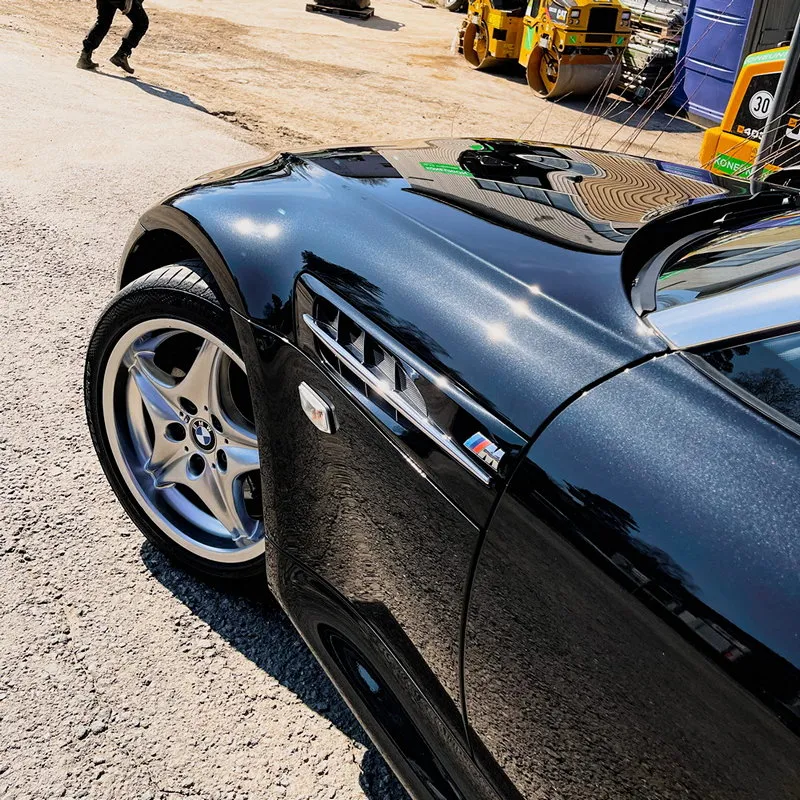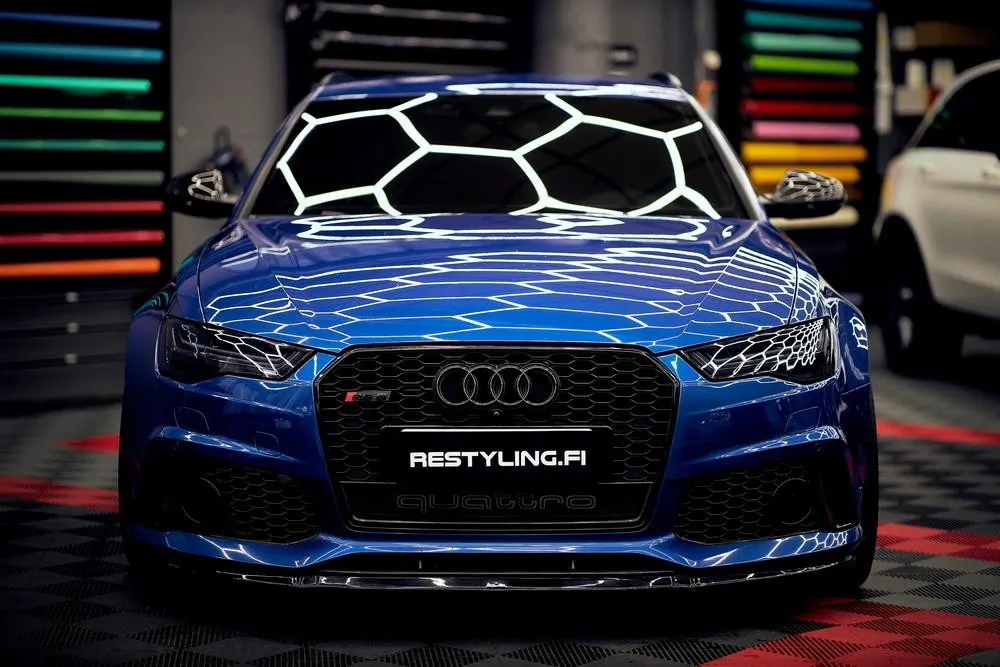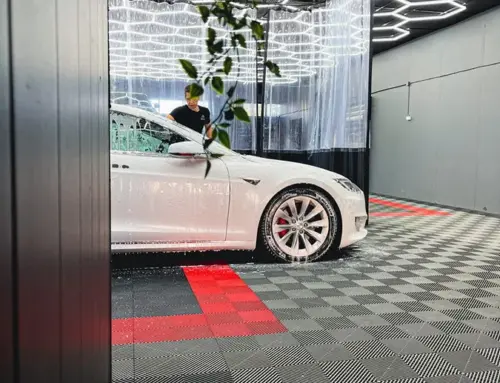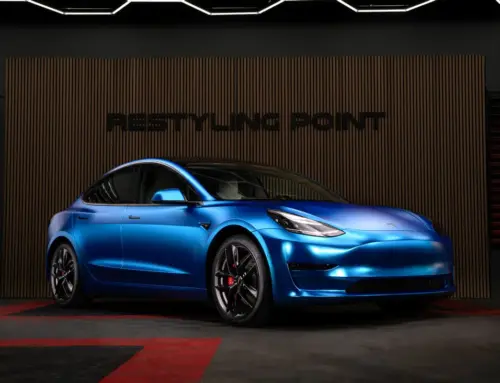- General
- Why protect a new car immediately
- What happens if you don’t protect a new car?
- Prevention
- How to protect a new car?
- Is it worth protecting the whole car with a film?
- Does the season affect car protection?
- Benefits of window tinting?
- Which colors should be protected especially?
- Do mileage and price affect the extent of protection?
- Is it worth protecting the wheels?
- Should anything be done to leather seats?
- Can glass surfaces be protected?
- Is it worth protecting a new leased car?
- Rare cases in new cars
General
When you buy your first new car, you might wonder how to protect it wisely. If you’re considering this question, take a look at your phone screen. Do you have a protective film over the glass? Or did you forget to put one on when you bought your new phone?
The glass might be scratched if it wasn’t protected by a film, or the film might be scratched from protecting the screen. We suggest you mirror this example with your car’s paint. The same thing happens to your car’s paint as it does to your phone screen.
We protect your car’s paint the same way Fonum protects your phone screen. We have thoroughly studied PPF (Paint Protection Film) and we know what we’re doing. We help you find the right solution for protection.
Why protect a new car immediately?
It is always recommended to protect a new car. The result of protecting a new car is also aesthetically more pleasing. When you bring your new car to us, it won’t develop any scratches or stone chips.

What happens if you don’t protect a new car?
If you decide not to protect your car when it’s new and think it will withstand all the wear and tear, you might get your car washed in automatic car washes and use it just for commuting. After a short while, you’ll notice stone chips forming on the hood and front bumper. On a black car, stone chips appear as small dot-like marks that you can feel with your fingers. The only way to fix these stone chips is by repainting. Larger and more obvious stone chips can be touched up, but even this isn’t a 100% perfect solution. Touch-up painting can also be surprisingly expensive if there are many stone chips.

When the paint on your car starts to fade, a black car becomes a dull gray, a red car turns matte, and a white car looks satin. This is a result of your car’s paint surface getting scratched. Scratched paint doesn’t reflect light back in the same direction it came from; instead, the light scatters in random directions and penetrates the scratches, reducing the shine. This is why your car no longer gleams like it did when it was new.
All these factors typically affect the resale value of your car. If your 3-year-old car looks like it’s at most a year old, this will increase its selling price. However, if your car is scratched and the front bumper and hood are full of stone chips, dealerships will have to spend a lot of money to get the car ready for sale. Think of protection as an investment in your property.


Prevention
We always recommend scheduling an appointment before the delivery date. This ensures that you can drive your car to us immediately, preventing any damage to the paint before it’s protected. This is a very common procedure with new cars.
When scheduling an appointment, let us know your desired outcome for the protection. Tell us your budget and any specific preferences you have. We will create the perfect package tailored to your needs. Our priority is not the money but ensuring your property remains in excellent condition through our expertise. Once you’ve scheduled a protection appointment, inform the dealership not to wash the car in an automatic brush wash before delivery. Unfortunately, this is a common practice at some dealerships. Also, remind them that the car doesn’t need to be waxed before delivery.
Keep an eye on your car’s delivery date, and if it changes, contact us immediately so we can adjust to the new schedule. New car deliveries often get delayed from the original delivery date. You can bring your car to us exactly as you receive it. If you have difficulties picking up the car or need assistance with logistics, we can pick up the car from the dealership for you. We charge for the Uber ride and the time spent.

How to protect a new car?
A new car can be protected in several ways. The most effective method is using PPF (Paint Protection Film). This film ensures that your car’s paint remains intact, absorbing all the common daily wear and tear. PPF is a premium material, so protecting your car with film is more expensive than using a ceramic coating.
The most popular and preferred choice among our customers at Restyling is to protect the front of the car, including the hood, front fenders, front bumper, headlights, and the lower parts of the doors and side skirts. This is called the “front and skirt package.” For the rest of the car, a ceramic coating is applied. This package protects the parts of the car that are under constant stress. Any stones or debris that hit the front of the car will impact the PPF film. The ceramic coating ensures that the car is easier to clean and keeps the paint color shiny. The coating also helps prevent very light scratches.
We offer a wide range of high-quality ceramic coatings with different durability levels. The most popular are the long-lasting coatings. Longer-lasting coatings are usually slicker and provide slightly better scratch resistance. These coatings have a self-healing function, meaning they can repair light scratches with heat. The scratch resistance of the coating is designed to combat very fine scratches, but it won’t prevent scratches from brush washes or snow brushes.
If you have children or pets, it’s important to consider the wear they can cause to the car’s paint. For example, door sills are areas where children’s shoes and pets’ claws often hit, and repeated wear can scratch and even rust the paint. By investing €89 – €99 in a PPF film for the door sills, you won’t have to worry about this issue anymore.
Have you ever noticed how your shopping bags or suitcase hit the top of the rear bumper when you take items out of the trunk? Or how your golf bag drags across the paint when you remove it from the trunk? Investing €89 – €99 in a rear bumper loading protector can prevent unnecessary contact and damage to the paint. Plastic bumpers are much more prone to scratching than metal ones, and removing scratches from plastic bumpers is more challenging due to the thinner clear coat.
Read our previous blog to learn about the differences between ceramic coatings and PPF films: restyling.fi/en/blog/difference-ceramic-coating-and-ppf
Is it worth protecting the whole car with a film?
You might have heard that your entire car can be protected in one go. This procedure has gained popularity due to the improved quality of materials.
By protecting the whole car with PPF, you get comprehensive protection all at once. If you’re willing to invest significantly in your new car, consider protecting the entire vehicle. This way, you can live stress-free with your car, never having to worry about protecting certain areas.
We have increasingly been doing full car protection as our customers have realized its benefits. Our customers have saved time and money because their car’s paint has been fully protected, meaning every impact affects the PPF film instead of the paint.
This procedure is strongly recommended for brand-new cars only. With used cars, there will be some preparatory work required for each panel.
The cost of a full car PPF film is always specific to the vehicle. For example, the cost for a Tesla Model Y with a glossy PPF film is €4999.
Various colors of paint protection films are constantly being introduced to the market. One of these is a matte/satin PPF film. This allows you to change your car’s color to a matte finish while simultaneously protecting the entire car. Matte PPF is slightly more expensive than glossy, but the result is more impressive. Matte PPF enhances the lines of the car and gives it a sportier appearance.
Read more in the Helsingin Sanomat article where we discuss the need for PPF film: Paint can be mummified with a wrap, which particularly interests Tesla owners. Sometimes the wrap is more expensive than the car. – HS Visio

Does season affect car protection?
Generally, no. However, the risks may increase in winter. Ice and snow can pose challenges to the durability of car protections.
PPF film naturally wears over time. This is normal and happens in all aspects of life. It’s something that no one can prevent or avoid. During winter, an unprotected car undergoes the most wear and tear, and the car’s paint is put to the test. Road salt and other road impurities constantly adhere to the paint surface. Your car is covered in snow, and you have to clean it off with a brush, causing scratches to the paint.
Especially before winter, it’s advisable to protect your car. With just a ceramic coating, your car becomes easier to maintain, and washing it in winter becomes quicker with better results. If your car delivery falls in early winter, it’s crucial to protect your car immediately and not wait until after winter. The amount of preparatory work increases every time the car is used. The more scratches the car’s paint suffers, the more preparatory work is required. Before installing the paint protection film, it’s advisable to paint significant stone chips so they don’t show through the film.
In summer, the biggest cost comes from mosquitoes and other insects that bake onto your car’s paint. These can only be removed by machine polishing. This is a cheaper procedure than preparing your car for protection after winter.
Challenges in winter:
- Ice and snow that damage the paint surface
- Brushing off snow with a snow brush that scratches surfaces
- Scraping ice off windows, and the scraper hitting the paint surface
- Interior getting dirty due to bad weather conditions
Challenges in summer:
- Insects baked onto the paint surface
- After winter, there are many loose stones on the roads that stress, for example, the side skirts
- Growth and narrowing of vegetation and roads, and the resulting scratches
Benefits of Window Tinting
Children’s skin is sensitive to UV radiation, and window tinting is an excellent way to protect your children’s skin. Window tint film provides up to 99% UV protection and up to 92% infrared heat rejection.
Window tinting also provides protection for your property; the film prevents visibility into the trunk. There are different degrees of darkness for the films, and with our expertise and measurement equipment, we can find the right darkness for you.
You can read about window tinting in our helpful guide:
restyling.fi/en/blog/4-tips-shade-window-tinting

Which colors should be protected especially?
Dark car colors, especially black cars, are the most susceptible to the human eye. All cars scratch just as easily, and marks occur in the same way. In a black car, all flaws and imperfections are significantly highlighted. For example, locating scratches on a white car is more challenging than on black cars. Light colors are a bit more forgiving than dark colors.
If you’ve bought a new black car, we don’t recommend this, but you can try wiping the lower edges of the doors with a glove and see with a lamp how each swipe brings more and more scratches to the surface. The need for protection is emphasized in dark cars. If you protect your car with, for example, PPF film, those unsightly swirl marks won’t catch your eye anymore.
(showing a Tesla Model 3 partially polished)

Do mileage and car price affect the extent of protection?
Simply put, yes. If you only drive 10,000 km a year, we recommend considering a lighter solution, such as protecting the lower edges of the doors, headlights, sills, and door thresholds. These are parts that will wear out regardless of the car’s usage.
If you drive over 35,000 km a year, the wear and tear are significantly higher. The front end of your car is already under considerable stress. Tell us how much your car is driven per year or provide an estimate. Based on this information, we can tailor a comprehensive solution for your use and your car model.
Plan the protection of your car according to the annual mileage. If the car is lightly used, choose a smaller package, or if your car is driven more than average, opt for a more comprehensive package.
Cars come in different price ranges, and it’s essential to consider the experience of the wrapping shop. Therefore, the rule of thumb is as follows:
- For cars costing €40,000 – €70,000 +, it’s advisable to protect at least the front end and sills, thresholds + other risks from details, such as the rear bumper corner.
- For cars costing €100,000 – €140,000 +, it’s advisable to wrap them with PPF paint protection film throughout, including the vertical bars between the windows and inner door thresholds.
- For cars costing €160,000 – €200,000 +, it’s advisable to protect not only the exterior but also the interior, including the windshield.
Is it worth protecting the wheels?
With ceramic coating, other areas of the car can be protected as well. For example, wheel protection has been extremely popular. With the coating, wheels no longer collect dirt on the inside, making cleaning easier. In winter, if the wheels collect ice and dirt on the inside, they may start vibrating, potentially causing hazardous situations. Clean wheels also look significantly better.

Is it worth doing something for leather seats?
Car seats are under constant strain. Leather seats easily get dirty, especially from pants. Specifically, the color of jeans tends to stick easily to light-colored leather. Cleaning this can be laborious and expensive. You may have noticed that food and drinks spilled from children’s hands can soil fabric seats very quickly. By coating the seats, this problem can be avoided. The coating creates a water-repellent layer on top of the seats, and any dirt that comes onto the seat sticks to the coating. Cleaning the dirt is very easy and effortless because of the coating. If you accidentally spill coffee on the seat, thanks to the coating, the liquid remains floating on the surface of the seat material and can be absorbed by a microfiber cloth.

instagram.com/stories/highlights/18002503804028061
Can glass surfaces be protected?
During the summer, you often have to keep the wipers at maximum speed to maintain visibility in the rain. Insects and other bugs stick to the glass and cleaning them off can be extremely difficult.
There’s a solution for all of this. Glass surfaces can be coated with a glass coating. This creates an extremely smooth surface on top of the glass, and the coating effectively repels water. In rainy weather, the water is usually removed from the glass starting at around 40 km/h due to airflow. In winter, the glass melts faster thanks to the coating. Cleaning off insects and bugs from the glass becomes easier and faster. Coating the glass is a very small investment in your safety, as visibility from your windshield improves, and the use of wipers decreases.
You’ll find pre-tailored coating packages from us. The packages include the parts of the car that we have deemed necessary to coat. There are three packages, each more extensive than the other. With these packages, you don’t have to worry about anything other than your budget; we’ll take care of the rest.
Is it worth protecting a new lease car?
We have been positively surprised by the amount of protection on lease cars. Every year, we protect more and more cars that are leased by companies for their employees.
In some cases, leasing companies may require the lessee to cover the damages caused to the car. This usually involves damage that is not normal wear and tear but rather an accidental occurrence.
For example, a customer’s car had a deep scratch from a parking lot. The leasing company demanded that the customer fix the scratch, or they would charge the lessee for the repair. The customer brought the car to us, and the scratch was fixed to the satisfaction of the leasing company.
By protecting your lease car with PPF film on even the essential areas, you can use your car more carefree. When the time comes to return the car, you don’t have to stress about any dings that may have occurred. The PPF film has done its job and helps maintain the car’s resale value.
Rare Cases in New Cars
A new car may sound like it comes completely flawless and untouched. This is the most common misconception, which, based on our experience, the vast majority form.
Over time, we have seen thousands of new cars, and not a single car has ever been completely flawless. In a new car, there is always debris under the clearcoat or in the paint mix. No paint job is 100% perfect. When you pick up your car, examine the paint and look for unusually large marks. In most cases, a skilled painter can remove debris from the clearcoat and smooth out the paint so that there is no trace of the debris removal.
In some cars, you may see holograms and swirls. This is the result of finishing the paint job after painting or trying to remove some scratches. Usually, machine polishings are done only until the desired defect in the paint is removed, and the job is left at that. However, the paint still needs to be finished to remove the swirls and holograms.
We have seen very deep scratches in cars that have penetrated through the clear coat, even though the car has only been driven 1 km. These scratches and marks usually occur during storage and transportation. Scratches and other marks do not belong to the car’s original condition. Do scratches and other marks belong to the original condition of a new car? As an example, see the picture below, where a brand-new Porsche Taycan had a scratch that went through the rear fender.

Removing scratches, holograms, debris, and other unusual marks must always be done before the installation of PPF film or ceramic coating, so that the surface under the film is in the best possible condition and a flawless surface is visible under the protective film or coating. This may affect the price, as additional work is required on the car that was not originally planned.
Inspect the car thoroughly on-site, examine each panel carefully. Consider whether it is worthwhile to accept the car if there is anything unusual on the paint surface.
Consider these things when buying a new car:
- Book an appointment with us in advance
- Ask us for help with finding the car
- Let us know your budget so we can build a package for you
- Drive the car directly to us when it’s brand new
- Avoid waxing or coating the car unnecessarily
- Research different companies offering car protection. The cheapest is not always the best
Do you want the job to be done responsibly, on schedule, and with the best value for your money? Ask for a quote from the professionals at Restyling Point, who do this with quality standards, values, and love.
On WhatsApp: +358445050624
Phone: +358445050624
By Email: [email protected]
Restyling Point Oy – Leading in Nordic wrap and protection treatments











